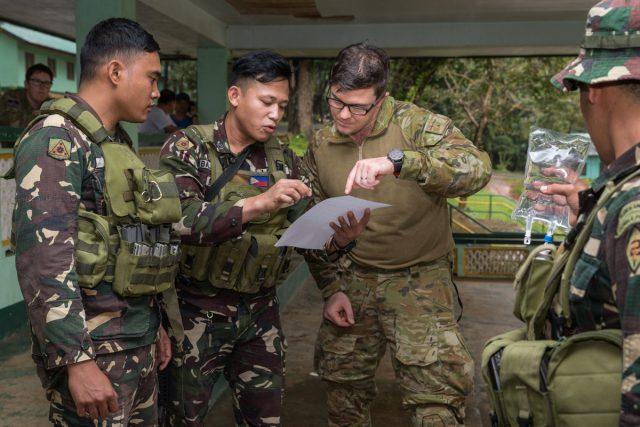
Australia’s engagement with the Philippines before, during and after the conflict in Marawi last year was more than just a humanitarian response. It signalled Australia’s maturation as a regional security actor and ‘provider of choice’ for our neighbours.
Australia has a strong interest in stopping Islamic State from taking root in Southeast Asia, so providing operational and policy support to regional partners remains a priority.
It’s worth examining both how Australia delivered help to the Philippines in Marawi and the lessons that were learned from the operation because it’s likely that similar help will be required in the region in the future.
In 2017, when the Philippines government put its armed forces in charge of restoring law and order in Marawi, Australia was able to offer technical expertise, lessons drawn from years of fighting and training local forces in Iraq and Afghanistan, and the loan of intelligence, surveillance and reconnaissance (ISR) capabilities that the Philippine military is still developing.
Under Operation Augury, Defence Minister Marise Payne authorised a package led by 1RAR commanding officer Lieutenant Colonel Benjamin McLennan as Joint Task Group 629. A flexible and adaptive urban warfare counterterrorism training program was quickly put together to upgrade Philippine skills, training and capacity. Australia also contributed two AP-3C Orion surveillance planes to provide ISR that enhanced the situational awareness of Philippine ground commanders.
In conjunction with the defence package, Foreign Affairs Minister Julie Bishop approved a Department of Foreign Affairs and Trade–led humanitarian assistance/disaster recovery package that was delivered through the World Bank. That made Australia the largest international humanitarian donor to Marawi: A$920,000 for humanitarian recovery, peace and stabilisation initiatives.
The decisions to limit defence help to an advisory role and not to embed Australia Defence Force personnel with Philippine troops in the fight, and not to provide continued support to the civilian reconstruction of Marawi, reflected Australia’s respect for Philippine leadership and policy priorities. They also recognised the existing capacity and experience of the Philippines.
Perhaps our most significant contribution to the post-conflict environment was hosting—in conjunction with the Philippine government’s inter-agency Task Force Bangon Marawi—a ‘Reconstruction, Recovery and Rehabilitation Seminar’ from 6–8 November 2017 in Manila. The seminar was designed for those involved in the campaign, as well as for their Australian counterparts, and aimed ‘to share their knowledge and experience regarding lessons learnt from whole-of-government post-conflict operations and to build networks across government’. It gave voice to more than 100 delegates from across the civil and military landscape.
Attendees included representatives from the Office of the Presidential Adviser on the Peace Process, Office of Civil Defense, Lanao del Sur provincial government, and Department of Public Works and Highways, among many others. The goal was to provide an understanding of the importance of civil–military partnership, but it also allowed the 80 Australian personnel deployed to the Philippines to quietly influence the post-conflict environment.
In setting the framework and program for the event, Australia was able to nurture working relationships with Philippine decision-makers in the task force. This helped Australian efforts to ensure a successful recovery operation that aimed to avoid creating conditions that would allow extremists to regain a foothold in disaffected communities.
The key message for Australian policymakers is that we can expect more Marawis in our region. The risk to regional stability posed by Islamic State’s goal of creating a ‘caliphate’ in Southeast Asia has by no means passed, and the urban conditions which led to this conflict remain widespread.
The Asian Development Bank calculates that by 2020, 13 of the world’s 25 megacities will be in littoral environments in Asia and the Pacific. The future security concerns will be centred on urban spaces because the sheer volume of people, buildings and transport systems will likely outstrip governance and service provision, generating instability and conflict as violent crime and disease increases, and as shortages of food, water and housing occur more frequently.
Megacities will bring new opportunities, but also new challenges, as disenfranchised and alienated communities develop around ethnic and sectarian lines. Violent non-state actors may seek out this environment because it provides concealment, serves recruitment and funding purposes, and can negate the technological advantages of local security forces.
Any conflict or stabilisation operation larger than Marawi would almost certainly see Australia being part of a coalition where even its whole-of-government response would make it a bit player. But when the next ‘Marawi’ happens, Australia can constructively contribute by replicating the considered, back-of-house and collegiate way it engaged to support the Philippines.
Acknowledging Philippine ownership of the situation, Australia indicated its willingness to contribute to a transregional security issue with ramifications far beyond the southern Philippines. Australia provided the appropriate support for, and augmentation of, existing Philippine capabilities and strengths—and can do so again.
Australia needs to capitalise on its capacity to provide this type of security assistance so that neighbours can see Australia as a preferred security partner and collaborator.